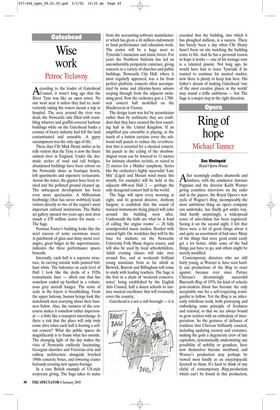Wise work
Petroc Trelawny
According to the leader of Gateshead Council, it wasn’t long ago that the River Tyne was like an open sewer. No one went near it unless they had to; inadvertently taking the waters meant a trip to hospital. The area around the river was dead, the Newcastle side filled with crumbling wharves and graffiti-covered harbour buildings while on the Gateshead banks a century of heavy industry had left the land contaminated and unusable. A gypsy encampment was the only sign of life.
These days Cllr Mick Henry smiles as he tells visitors that the Tyne is now the finest salmon river in England. Under the dramatic arches of road and rail bridges, abandoned buildings have been reborn on the Newcastle shore as boutique hotels, loft apartments and expensive restaurants. Across the water, the gypsies have been resited and the polluted ground cleaned up. The subsequent development has been even more spectacular. A Millennium footbridge (that has never wobbled) leads visitors directly to two of the region’s most important cultural institutions. The Baltic art gallery opened two years ago; next door stands a £70 million centre for music The Sage.
Norman Foster’s building looks like the steel cocoon of some enormous insect. A patchwork of glass and shiny metal rectangles, great bulges in the superstructure, indicates the three performance spaces beneath.
Internally, each hall is a separate structure, its curving outside walls painted brilliant white. The balconies on each level of Hall 1 look like the decks of a 1920s transatlantic liner — albeit one that has somehow ended up berthed in a voluminous grey aircraft hanger. The sense of scale in the foyers is breathtaking. From the upper balcony, human beings look like matchstick men scurrying about their business below. Alas, the vastness of the concourse makes it somehow rather impersonal — a little like a transport interchange. Is there a risk that the place will only truly come alive when each hall is hosting a sellout concert? What the public spaces do magnificently is to frame what lies outside. The changing light of the day makes the vista of Newcastle endlessly fascinating; Georgian churches and Victorian civic and railway architecture alongside botched 1960s concrete boxes, and towering cranes furiously creating new square-footage.
In a rare British example of US-style corporate giving, The Sage takes its name from the accounting-software manufacturer which has given a £6 million endowment to fund performance and education work. The centre will be a huge asset to Tyneside’s musicians and music lovers. For years the Northern Sinfonia has led an uncomfortably peripatetic existence, giving concerts in a variety of churches and public buildings. Newcastle City Hall, where it most regularly appeared, was a far from perfect platform, concerts often accompanied by noise and chlorine-heavy odours seeping through from the adjacent swimming-pool. Now the orchestra gets a 1,700seat concert hall modelled on the Musikverein in Vienna.
The design team was led by acousticians rather than by architects; they are confident that they have created the best sounding hall in the United Kingdom. If an amplified jazz ensemble is playing, at the touch of a button curtains cover the ashwood wall panels to reduce the reverberation that is essential for a classical concert. Six panels in the ceiling of the shoeboxshaped room can be lowered to 11 metres for intimate chamber recitals, or raised to 21 metres for a Mahler symphony. Series like the orchestra’s highly successful ‘Late Mix’ (Ligeti and Mozart wind music this month, for example) will be held in the adjacent 400-seat Hall 2 — perhaps the only decagonal concert hall in the world.
The Sage will open every morning at eight, and its general director, Anthony Sargent, is confident that the sound of musical instruments being played will echo around the building soon after. Underneath the halls are what he is fond of calling ‘the engine rooms’ — 28 fully soundproofed music studios, flooded with natural light. On weekdays they will be the base for students on the Newcastle University Folk Music degree course, and will also be used by local schoolchildren. Adult evening classes will take over around five, and at weekends brilliant young musicians from as far afield as Berwick, Barrow and Billingham will come to study with leading teachers. The Sage is the first in a chain of ‘weekend conservatoires’ being established by the English Arts Council, half a dozen schools to nurture musical excellence that will eventually cover the country.
Gateshead is a not a rich borough — it is essential that the building, into which it has ploughed millions, is a success. There has barely been a day when Cllr Henry hasn’t been on site watching the building come to life. And he has a personal reason to hope it works — one of his teenage sons is a talented pianist. Not long ago, he would have had to leave Tyneside if he wanted to continue his musical studies; now there is plenty to keep him here. His father’s dream of making Gateshead ‘one of the most creative places in the world’ may sound a trifle ambitious — but The Sage is a major step in the right direction.










































 Previous page
Previous page